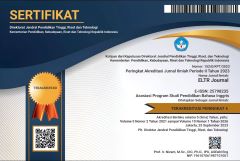DUOLINGO: AN ENCHANTING APPLICATION TO LEARN ENGLISH FOR COLLEGE STUDENTS
Abstrak terlihat: 1534 / PDF terunduh: 1160DOI:
https://doi.org/10.37147/eltr.v7i2.176Keywords:
Duolingo, language, learning, mediaAbstract
Technology in learning is increasingly used as a medium, especially in learning English. This rapid development has also significantly impacted the gamification concept, which has begun to penetrate digitally. Duolingo, the game-based world's wildly popular language-learning app, is one of those impacts. This paper aims to find out the use of Duolingo in learning English by college students. The method of this study is qualitative, with a questionnaire as the instrument to collect the data. The participants are students from several universities in Indonesia. The study reveals that, Duolingo is considered an application that greatly supports college students in learning English and is an application that has effective innovation amid the rapid development of technology.
Downloads
References
Andayani, E.S. (2022). The importance of learning and knowing English in higher education in Indonesia. Research and Development Journal of Education 8(1), 372–79.
Aspers, P., & Corte, U. (2019). What is qualitative in qualitative research. Qualitative Sociology, 42, 139–160. https://doi.org/10.1007/s11133-019-9413-7
Astarilla, L. (2018). University students' perception towards the use of Duolingo application in learning English'. CelSciTech-UMRI, 3, 1–9.
Docan-morgan, T., & Nelson, L. (2015). The benefits and necessity of public speaking education. In K. Vaidya, J. burns, T. Docan-Morgan, K. Owens, D. Leonard, & R. Rosenthal (Eds.), Public speaking for the curious: Why study public speaking (pp.1-16). The Curious Academic Publishing.
Dutta, S. (2020). The importance of "English" language in today's world. International Journal of English Learning & Teaching Skills, 2(1), 1028–1035. https://doi.org/10.15864/ijelts.2119.
Fitri, N., & Zainil, Y. (2018). Enhancing college students' reading comprehension through critical reading. Journal of English Language Teaching, 7(4),644–53. https://doi.org/10.24036/jelt.v7i4.101323
Garcia, I. (2013). Learning a language for free while translating the web. Does Duolingo work? International Journal of English Linguistics, 3(1), 19– 25. https://doi.org/10.5539/ijel.v3n1p19.
Grieve, J. (2015). Dialect variation. In D. Biber & R. Reppen (Eds.), The Cambridge handbook of English corpus linguistics (pp. 362-380). Cambridge: Cambridge University Press. https://doi.org/10.1017/CBO9781139764377.021
Habibie, A. (2020). Duolingo as an educational language tool to enhance EFL students' motivation in learning. Jurnal Bahasa Dan Literature, 9(1), 13–26.
Hikmah, D. (2019). Media for language teaching and learning in digital era. International Journal of English Education and Linguistics (IJoEEL), 1(2), 36–41. https://doi.org/10.33650/ijoeel.v1i2.963.
Inayah, N., Yusuf, Q., & Fibula, N. (2020). Exploring undergraduate students' perception toward the use of Duolingo in learning English. Humanities & Social Sciences Reviews, 8(3), 76–85. https://doi.org/10.18510/hssr.2020.839.
Indrasari, A., Novita, D., & Megawati, F. (2018). Big book: Attractive media for teaching vocabulary to lower class of young learners. JEES (Journal of English Educators Society), 3(2), 141–54. https://doi.org/10.21070/jees.v3i2.1572.
Jašková, V. (2014). Duolingo as a new language-learning website and its contribution to e- learning education (Diploma thesis). Brno: Masaryk University.
Krashen, S. (2014). 'Does Duolingo "Trump" university-level language learning? The International Journal of Foreign Langauge Teaching, 9(1), 13–15.
Ningrum, A.K. (2022). An analysis of listening comprehension problem on communicative listening subject at the second semester of English language education program (Undergraduate thesis). Universitas Islam Riau, Pekanbaru, Indonesia.
Ningsih, I.H., Winarni, R., & Roemintoyo, R. (2019). The importance of early reading learning in the face of 21st century education. AL-ASASIYYA: Journal of Basic Education, 3(2), 196-205. https://doi.org/10.24269/ajbe.v3i2.1879.
Nushi, M., & Eqbali, M.H. (2017). Duolingo: A mobile application to assist second language learning. Teaching English with Technology, 17(1), 89–98.
Parmawati, A., & Inayah, R. (2019). Improving students' speaking skill through English movie in scope of speaking for general communication. Eltin Journal: Journal of English Language Teaching in Indonesia, 7(2), 43–53. https://doi.org/10.22460/eltin.v7i2.p43-53
Pham, A.T. (2022). University students' perceptions on the use of Quizlet in learning vocabulary. International Journal of Emerging Technologies in Learning, 17(7), 54–63. https://doi.org/10.3991/ijet.v17i07.29073.
Picton, I. (2019). Teachers' use of technology to support literacy in 2018. A National Literacy trust Report, 1-35
Prayudi, R.A., Hakiki, A.K., Putra, N.R.D., Anzka, T.O., & Ihsan, M.T. (2021). The use of technology in English teaching & learning process. Jurnal Riset dan Inovasi Pembelajaran, 1(2), 102–11. https://doi.org/10.51574/jrip.v1i2.38.
Purwanto, A.A, & Syafryadin, S. (2023). Students' perception on using Duolingo for learning English vocabulary. Journal of English Teaching, 9(1), 70–82. https://doi.org/10.33541/jet.v9i1.4506.
Tahir, R., & Wang, A.I. (2017). State of the art in game-based learning: Dimensions for evaluating educational games. Proceedings of the 11th European Conference on Games Based Learning, ECGBL 2017 (December), 641–50.
Wardiani, R., Mulyaningsih, I., & Maneechukate, S. (2021). Writing skills development: A Balancing perspective of brain function in elementary schools. Al Ibtida: Jurnal Pendidikan Guru MI, 8(1), 65-79. https://doi.org/10.24235/al.ibtida.snj.v8i1.7795.
White, K. (2017). Duolingo: All the buzz. The Linguistic, 53(1),17-18.
Downloads
Published
How to Cite
Issue
Section
License
Copyright (c) 2023 Diah Permatasari, Farida Aryani

This work is licensed under a Creative Commons Attribution-ShareAlike 4.0 International License.













